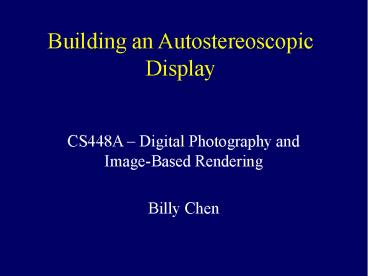Building an Autostereoscopic Display - PowerPoint PPT Presentation
Title:
Building an Autostereoscopic Display
Description:
Building an Autostereoscopic Display. CS448A Digital Photography and Image-Based Rendering. Billy Chen. Original Goals. dynamic, real-time display ... – PowerPoint PPT presentation
Number of Views:172
Avg rating:3.0/5.0
Title: Building an Autostereoscopic Display
1
Building an Autostereoscopic Display
- CS448A Digital Photography and Image-Based
Rendering - Billy Chen
2
Original Goals
- dynamic, real-time display
- convenient 3D display for the home (3D desktops)
- autostereoscopic light field viewer
3
Display design choices
Display Type Resolution Advantage Disadvantage
CRT/LCD 72-115 dpi cheap, everywhere low resolution, challenging calibration
Projector 150 dpi easier to control pixel depth, adjustable angular resolution projector distortion
Big Bertha 211.66 dpi higher resolution expensive, need special hardware to drive it
Printer 300 dpi high resolution static images
4
Physical Setup
5
Overview of display process
Calibration
6
The calibration problem
7
Calibration
- affine transformation correction (mostly scale)
- projective transformation correction
8
Calibration solution 1
- OpenGL program displays a moiré pattern
- can calibrate up to affine transformations
- most effective for finding correct size
9
Calibration solution 2
p
A
A
h
p
B
B
Finding the homography without getting projector
parameters
10
Calibration solution 2
x y 1
cx cy c
M
M p cp
Let Mi ith row of M
(1) M1p cx (2) M2p cy (3) M3p c
y (M1p) - x(M2p) 0
M1p - x(M3p) 0
M11
xy yy y -xx -yx -x 0 0 0
M12
0
M13
.
.
M21
.
.
.
.
9x1
8x9
A
Take SVD(A) and look at matrix
11
Calibration solution 2
12
Rendering
- sampling the light field
- computing lenslet distances
- cropping and compositing
13
Rendering Sampling a light field
Isaksen et al., Siggraph 2000
14
Getting floating images
Halle, Kropp. SPIE 97
15
Sampling a light field
16
Rendering computing the FOV
17
Rendering compositing and cropping images
subsample
crop
composite
18
Implementation Details
- Fresnel hex array 300 0.12 in. focal length,
0.12 in. thickness, .09 in. diameter - default size for a lenslet image 26x31 pixels
(for 300 dpi displays) - calibrate scale is .49 (sanity check 300 dpi /
150 dpi) - OpenGL unit 1 pixel (300 dpi)
- SEE WEBPAGE!
19
Results compared to original goals
- real-time display is hard, must handle the
bandwidth - spatial resolution too small for 3D desktops
- light fields have problems with much depth
complexity, but NEED depth for effective
autostereoscopic displays
20
Future Work
- reflective display
- auto-calibration
- hardware accelerated light field sampling
- overloading pixels per direction perspective
views, displacing display pixels from focal plane - use a light field of captured data
21
Acknowledgements
- calibration Vaibhav Vaish
- light field generator Georg Petschnigg
- hardware accelerated approach Ren Ng
- bootstrap Sean Anderson































